 |
The Bead Site =Home>Beadmaking & Materials>Faience
Faience
Egyptian Faience Amulets
Definition: Faience is the oldest artificial substance, first made (probably in Egypt)
5,500 years ago, a millennium before glass was invented. While similar to glass in some ways, it differs in others. It has a core of quartz particles are fused to each other only where they touch (this is called "sintering"). Over the core is a glaze, a thin layer of glass, applied in different ways. Much faience has lost its glaze because the core and glass expand and contract at different rates as it gets hotter or colder.
|
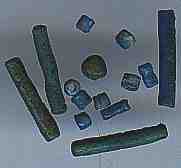
|
The most common Egyptian shapes were thin tubes and short cylinders cut from the tubes, probably made around straws. The beads were used for the living and the dead. The tubes went into the oft-gifted Broadcollars and "mummy nets." Shades of blue and green are the usual colors if the glaze remains.
|
|
Other shapes, were also used, especially for amulets.
Donor here and above: Mrs. F.E. Willsie of Victoria, B.C., Canada.Who?
|
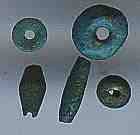
|
|
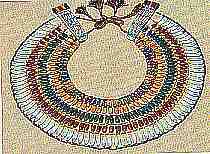
|
The glaze of faience, being glass, can be colored. This was done especially in the Armarna Period, when the heretic monotheist Akhenaten was Pharaoh. Several necklaces like this were found in the tomb of his son, King Tut.
|
|
The Romans used faience to make some of their own amulets. On the left is a phallus and on the right an altar.
However, by Roman times, glass became a more important bead material.
|
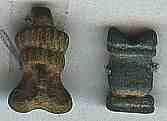
|
|
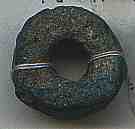
|
Faience was still being made in Egypt in the Islamic period, but all of it seems to be large, crude beads, put onto animals to ward off the Evil Eye. The blue color was effective in saving the animal from the witch's glance.
|
|
Faience was made in many countries other than Egypt. These beads date to ca. 1500 B.C. and were made either in Iran or Mesopotamia.
|
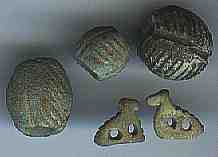
|
|
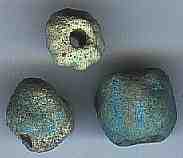
|
Iran continued to produce faience beads for along time. Beads like these are found from ca. 500 B.C. through the Islamic period. I believe their use was strictly for animals. They have all lost their glaze.
|
|
A faience representation (in two colors) of a Muslim charm case, meant to hold a phrase from the Qoran or a magic square. It was likely made in Iran, ancient Persia.
|
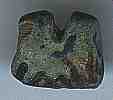
|
|
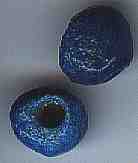
|
Iran remains the only place today where traditional faience is being made (modern Egyptian faience is made from soapstone mostly for the tourist trade). These "donkey beads" were made in the holy city of Qom.
|
|
Carol Strick spent many years researching faience and made remarkable reproductions of ancient Egyptian pieces. Upper left is a clay mold. Donor: Carol Strick.
|
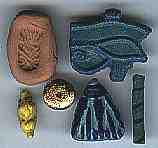
|
|
Source: Floral Broadcollar: Cyril Aldred 1978 Jewels of the Pharaohs: Egyptian Jewelry of the Dynastic Period.
London: Thames and Hudson.
Egyptian Faience Amulets
Egyptian Amulets
__________________________________________________
Small Bead Businesses | Beading & Beadwork | Ancient Beads | Trade Beads
Beadmaking & Materials | Bead Uses | Researching Beads | Beads and People
Center for Bead Research | Book Store | Free Store | Bead Bazaar
Shopping Mall | The Bead Auction | Galleries | People | Events
The Bead Site Home | Chat Line | Contact Us | Site Search Engine | FAQ
|
 |









